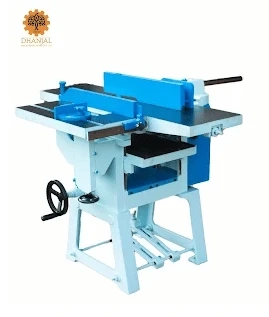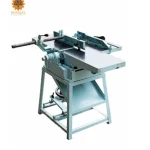The planer machine is a piece of equipment used to create precise plane surfaces and slots. The shaper machine and this one have a similar appearance, but they differ in a few key ways.
The size of the planer machine is significantly larger than that of the shaper machine, and most significantly, whilst the work piece reciprocates in the shaper, the tool does not in the planer. A single point cutting tool, like those used in shaper or slotter machines, is the tool used in a planer machine.
The idea of relative tool-work movements serves as the planner machine\'s guiding premise. The fast straight path cutting motion imparts reciprocation of the tool or job as well as the slow, intermittent transverse feed motions.
Any task carried out by planning machines may be performed by the shaping machine. The longer strokes, larger diameters, and improved stiffness of the combined planer machine enable them to perform more demanding work on large works and their extended surfaces.
With a single-point cutting tool, it creates planes and flat surfaces. In comparison to a shaper machine, a planer machine is enormous and powerful. Heavy workpieces can be machined on a planer, however they cannot be machined on a shaper surface.
Parts of Planer Machine
Generally speaking, planer machines consist of the following components:
Bed
Cast iron is used to create the heavy, box-like structure. To allow for table mobility, it has slots, often V-slots, all over its surface. Aside from housing the table\'s movement mechanism, it supports the columns and carries all of the machining loads.
Table
A rectangular piece of high-quality cast iron serves as the table as well. It moves reciprocally with the bed slots and serves primarily as a support for the work piece. In order to prevent any type of dimensional error in the work piece during the planning operation, the top of the table is very precisely and finely machined.
Columns (Housing)
The bed\'s two sides are each supported by a vertical box-shaped column that is positioned perpendicularly. Its primary jobs are to hold the cross rail in place and serve as a housing for the side tool head. The cross rail\'s movement mechanics are also housed there, in addition to this.
Cross Rail
The horizontal railing that spans the bed and is held up by columns is known as the cross rail. The vertical tool head is housed within the cross rail, which further adds to the machine\'s stiffness. Thanks to a lead screw that is located in the column, it may be raised or lowered.
Tool Heads
A planer machine typically comes with three tool heads. The top tool head is where the tool that will be used to machine the work piece\'s upper surface will fit. However, the side ones are used to machine the work piece\'s side surfaces.
Working Principle of a Planer
The machine\'s tool head is in a stationary position, but the worktable may be moved. On the workbench, the piece of art is fastened, and
When we turn on the machine, electricity is now supplied to the machine and the worktable moves forward. The single point cutting tool or end cutter machine is now fastened to the tool head.
As a result, it slices the material and is known as a cutting stroke. The downward movement of the worktable without any material being cut is referred to as the return stroke. If you don\'t alter the power source or any other factors, the procedure will continue.
Mechanisms of Planer Machines
Transforming and transmitting the motor\'s rotation into the work table\'s reciprocating motion and the tools\' transverse movements are both aspects of kinematics.
A rack-pinion system creates the reciprocating motion of the table that moves the workpiece while cutting. The speed gearbox\'s output shaft is mounted with the pinion, and the rack is fitted with a table.
By using a screw-nut system, the blocks retain the cutting tools that move along the rail horizontally, while a separate screw-nut pair moves the rail up and down.
To alternately reciprocate the table, the belts are employed as drives. The bigger pulley\'s longer arc of contact is employed to drive the table.
Types of Planer Machines
There are five distinct types of planer machines:
- Open Side Planer Machine
- Double Housing Planer Machine
- Edge Planer Machine
- Divided Table Planer Machine
- Pit Planer Machine
Open Side Planer Machine
There is a housing that a cross rail on a table travels on that is fastened to or clamped to one side of the base.
There are three tool heads fitted on the machine for open side planing. The entire load will be supported by a single housing, thus it must be sturdy and force-resistant to withstand the stresses.
The housing\'s guide ways, which carry the tool heads, allow it to glide along them in a vertical manner.
Double Housing Planer Machine
A double housing planer machine is used in most of the factories. When a table reciprocates on a double housing planer, a long, heavy base with precise machined guide ways supports the unit. In comparison to the table, the bed is longer by more than twice that much.
Two vertical housings are installed on one housing, one on each side, and these are joined at the top by a cross member. Two tool heads that glide across the machine housing\'s vertical sides are supported by a horizontal cross rail on the device.
In order to perform the feeding process, tool heads are moved crosswise or vertically by hand or by power. The stiff, heavy-duty, and fast double housing planer is a piece of equipment.
Tool heads can be automatically or manually moved in a cross or vertical direction during the feeding process. The strong, powerful, and quick double housing planer is a piece of equipment.
The outside is quite neatly done. While holding the tool on the machine frame, a rotating table with attached work revolves. It has the ability to apply high feeds and make deep cuts to finish the job swiftly. The instrument is immobile, while the work is in motion. The use of larger, more powerful, and heavier tools is common.
The speeds of cutting and returning are constant. A double housing combi planer machine can handle a large amount of floor space and requires 150 horsepower to operate.
Edge Planer Machine
An edge planer, also known as a plate planer, is a tool used to square and bevel the edges of steel plates used for pressure vessels in a variety of industries and the shipbuilding industry.
The work that is kept in place is kept on the table. Air-operated clamps can be used to secure the work piece. Two horizontal guide ways are used to move the tool head that mounted on the carriage.
Divided Table Planer Machine
Two tables on the bed of the divided table planer machine can reciprocate singly or together. This will cut down on idle time when you start working.
The majority of the time, mass manufacturing tasks that may be The machine must be operated exactly the same way; after loading the job onto one of the tables, the other component can reciprocate the cutting tool to complete the task.
After the table has stopped and the completed task has been expelled, the remaining work can be completed by moving the table to the end. Large and heavy tasks are secured together in order to allow the tool to reciprocate.
Pit Planer Machine
The table of a pit planer is maintained in a pit and is kept still. On a horizontal rail installed on both sides of the table, the crossing rail reciprocates.
Heavy work may be loaded since the planer\'s table is level with the floor. It includes two tool heads that may be adjusted both horizontally and vertically to control the feed. The column is driven by a driving screw, which is powered by a motor.
How a Planer Machine Operates?
Operations on a shaper are similar to those carried out on a planer.
The sole distinction is that the shaper can only process tiny work, whilst the planer is specifically made for machining huge work.
On a planer machine, the following tasks are often performed.
- The process of flattening surfaces
- Preparing vertical surfaces for planing
- Manufacturing angles
- Preparing curved surfaces for planing
- Slots and grooves are planed




